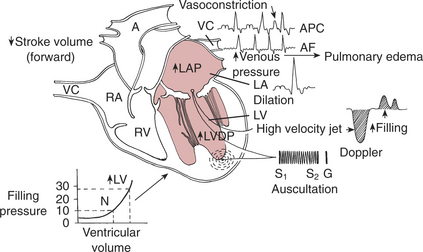Chapter 149 Valvular Heart Disease
VALVE FUNCTION AND DYSFUNCTION
Valve Dysfunction
Valvular stenosis is almost always a congenital abnormality in animals. Valvular regurgitation may develop from congenital malformation or acquired diseases. Common anatomic and functional causes of AV valvular regurgitation are listed in Table 149-1.
Table 149-1 CAUSES OF ATRIOVENTRICULAR VALVULAR REGURGITATION*
Congenital mitral valve dysplasia (MR)
Congenital tricuspid valve dysplasia (TR)
Chronic degenerative (myxomatous) valvular disease (endocardiosis causing MR, TR)
Ruptured chordae tendineae (MR, TR)
Avulsion of the papillary muscle (MR, TR)
Transmural myocardial infarction (MR)
Causes of ventricular or atrial dilation leading to AV valve regurgitation
Ventricular septal defect/endocardial cushion defect (MR, TR)†
Pulmonary regurgitation (must be severe to cause TR)
Myocarditis—for example, parvovirus, Chagas’ disease (MR, TR)
Dilated cardiomyopathy (MR, TR)
Intermediate/restrictive cardiomyopathy (MR, TR)
Atrial muscular dystrophy—“silent atrium” (MR, TR)
Right ventricular cardiomyopathy—RV dysplasia (TR)
Hyperdynamic circulation—AV fistula, anemia, hyperthyroidism (MR, TR)
Chronic bradyarrhythmia—for example, complete AV block (MR, TR)
Causes of left ventricular hypertrophy (causing MR)
Systemic hypertension—for example, chronic renal disease
Causes of right ventricular hypertrophy (causing TR)
MR, mitral regurgitation; TR, tricuspid regurgitation.
Cardiac Murmurs
A hallmark clinical finding in valvular heart disease is a cardiac murmur. Murmurs are produced by high velocity and turbulent blood flow across the valve as the blood moves from a higher to a lower pressure chamber or vessel. With few exceptions, the absence of a cardiac murmur usually excludes the presence of clinically significant valvular disease (see Chapter 142).
VALVULAR DISEASES OF CLINICAL IMPORTANCE
Congenital Aortic Stenosis
This lesion usually is a subvalvular fibrous obstruction, although the lesion may extend to the valve proper (see Chapter 154 for a discussion of congenital valvular disorders).
Congenital Pulmonic Stenosis
A variety of anatomic lesions may contribute to narrowing of the right ventricular outflow tract, pulmonic valve, or pulmonary artery (see Chapter 154).
Congenital Mitral and Tricuspid Valve Dysplasia
Anomalies of the chordae tendineae, papillary muscles, valve cusps, or valve annulus can lead to incompetency or, less commonly, to stenosis of the valves (see Chapter 154).
AV Valvular Regurgitation Due to Cardiomegaly or Cardiomyopathy
Valvular regurgitation may develop secondary to ventricular or atrial dilation or ventricular hypertrophy related to a variety of causes (see Table 149-1). For example, acquired mitral regurgitation in cats is typically caused by a form of cardiomyopathy.
CHRONIC VALVULAR DISEASE (ENDOCARDIOSIS) IN DOGS
Pathology
Pathophysiology
Endocardiosis represents a progressive process and does not cause detectable signs during the earliest period of structural changes. Progressive valvular distortion leads to detectable valvular insufficiency with accompanying cardiac enlargement. Mitral regurgitation (MR) causes left ventricular volume overload, left heart failure, pulmonary hypertension, and predisposes to cardiac arrhythmias (Fig. 149-1). However, heart failure does not develop in all dogs. The entire process usually requires many years, although some breeds (e.g., Cavalier King Charles spaniel) are affected relatively early in life and may have a rapid progression to heart failure.
Increased Pulmonary Venous Pressure
LA and pulmonary venous (PV) pressures increase for a number of reasons:
Cardiac Arrhythmias
Arrhythmias are common and can further decrease cardiac output (see Chapter 145).
Left Atrial Rupture
Rupture of the mitral valve chordae tendineae, the development of sustained atrial tachyarrhythmias, and LA rupture are important diagnostic considerations when rapid hemodynamic deterioration occurs in dogs with chronic MR. Appropriate therapeutic intervention can stabilize many of these patients, allowing sufficient time for further compensation.
Clinical Signs and Diagnosis
History
Physical Examination
Auscultation
Stay updated, free articles. Join our Telegram channel

Full access? Get Clinical Tree



